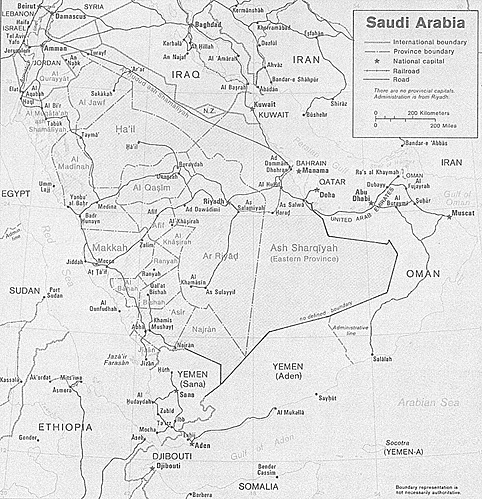 GEOGRAPHY AND CLIMATE
GEOGRAPHY AND CLIMATE
Saudi Arabia is a large country. It occupies most of the Arabian Peninsula, an area about the size of the United States east of the Mississippi River. Its exact size is uncertain because many of its boundaries are not firmly defined. It is about 2,217,949 square km. The vast majority of its territory is desert.
Jumbo Map: Saudi Arabia (extremely slow: 418K)
Saudi Arabia has three great deserts. The Nafud in the north along the Saudi borders with Jordan and Iraq. The Ad Dahna runs from northern Saudi Arabia along the Saudi-Iraqi neutral zone south through the center of the country. The third and largest desert is the Rub Al Khali. The Rub Al Khali is over a half million square km in area and is located along the Saudi's southern border with Yemen and Oman.
Western Saudi Arabia, along the Red Sea, is made up of two mountain ranges, the Hijaz in the north, and the Asir in the south. Although both ranges are low, the Hijaz rises between 2,000 and 6,000 feet and the Asir, up to 9,000 feet. Both are rocky and steep, especially on the western sides. On the eastern sides, both slope gradually down to an extensive rocky plateau called the Najd. The Najd extends east to the center of the Arabian peninsula where it meets the desert, Ad Dahna.
East of the Ad Dahna is another rock plateau, the Summan Plateau. Lower in elevation than the Najd, the Summan Plateau gradually drops in elevation to the flat coastal plains along the Persian Gulf.
Saudi Arabia has a desert climate characterized by extremely high temperatures during the day and sharp drops in temperatures at night. The temperature along the coastal regions near the Red Sea and the Persian Gulf is moderated by the presence of these bodies of water. In these areas, the temperature seldom rises above 100 degrees F, but the relative humidity is unusually high.
Inland, on the rocky plateaus of Najd and Summan, as well as in the deserts, the temperature can reach as high as 130 degrees F. The heat gains intensity immediately after sunrise and dissipates at sunset, producing relatively cool nights. The almost nonexistent humidity of the central plateaus and deserts, combined with relatively low temperatures, can make nights on the Arabian Peninsula seem bitterly cold.
For most of the country, rainfall is slight and erratic. A region's entire annual rainfall may come in one torrential downpour. For this reason, most of the country's scarce water supply comes from springs and artesian wells. In the central portion of Saudi Arabia, Najd and the three deserts' natural wells and springs are few and scattered. Water must be hauled or pumped to the surface and its quality may be poor. In Eastern Arabia, and in the western mountains, wells and springs are relatively more common. Large numbers of these wells and springs in local areas constitute oasis where the water is used for irrigation and agriculture.
Back to Table of Contents -- Winning in the Desert
Back to CALL List of Issues
Back to MagWeb Magazine List
© Copyright 2004 by Coalition Web. Inc.
This article appears in MagWeb.com (Magazine Web) on the Internet World Wide Web.
Other articles from military history and related magazines are available at http://www.magweb.com